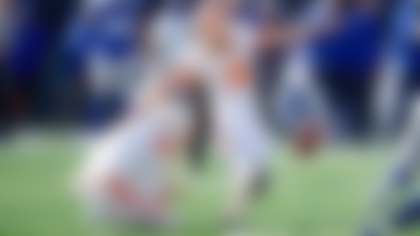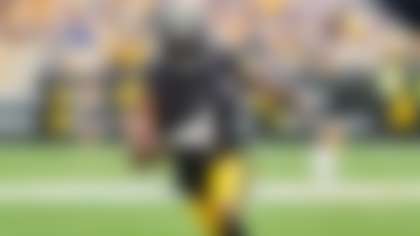Championship Sunday truly provides the best the NFL has to offer this season, with the top two seeds from each conference -- and four highest-scoring teams -- doing battle. So, how will these two title bouts play out? What will be the deciding factors? In seeking such answers, it's always helpful to identify potential mismatches. This is the task I took to my model this week.
How does my model work? Well, I don't want to bog down this piece right off the bat with a procedural primer. Plus, I know some of you are familiar with my methodology from prior files. So, for any inquiring minds, I've supplied a quick rundown on how my models operate at the bottom of this page. For the rest of you (sane) people, let's get to the meat of the matter!
Without further ado, my model has crunched historical data and flagged one key matchup on each side of the ball for both of Sunday's games:
How much will the Saints miss Rankins, who suffered a torn Achilles last weekend? First, let's look at the team's splits with and without the defensive tackle on the field. In 196 rushing downs with Rankins on the field, New Orleans allowed 3.4 yards per play, gave up runs of 10-plus yards at a rate of 6.6 percent and achieved a stuff rate of 23 percent. In 174 rushing downs without Rankins, those numbers changed for the worse: Yards per play jumped to 3.8, the 10-plus-yard-run rate increased to 10.3 percent and the stuff rate dropped to 21.2 percent. Moreover, my computer-vision measurements show that without Rankins on the field, opposing offenses either converted a first down or saw short-yardage situations on later downs at a rate that was 18 percent greater than they did when Rankins was on the field. These are not promising figures for the Saints when you consider Rams running back Todd Gurley averages 5.2 yards per rush between the tackles (ranking fourth amongst RBs with 100-plus rushing attempts between the tackles), according to Pro Football Focus. Meanwhile, the emergence of C.J. Anderson in Los Angeles has also meant an increased use of heavier sets, which will be less favorable for New Orleans to face sans Rankins. (Until Week 16, L.A. used 11 personnel on 96.6 percent of its offensive plays; since then, the Rams' use of 12 personnel is up from 1.2 percent to 41.3 percent, including playoffs.)
Rankins' absence will also impact New Orleans' pass defense. Without him on the field, the Saints' pressure rate dropped from 30.3 percent to 25.1 percent, while their sack rate was cut nearly in half (9.1 percent to 4.7 percent). There just aren't historical look-alikes for a guy of Rankins' size who disrupts the game in the same way while lining up where Rankins does. His traditional stat line -- even his eight sacks -- doesn't accurately reflect the impact he has. Rankins' game-saving Week 16 tackle of (Steelers fans, please skip to the next sentence) Pittsburgh receiver JuJu Smith-Schuster, which resulted in a forced fumble with 41 seconds left in a 31-28 Saints victory, crystallizes this.
Putting it all together, Rankins' combined run-stopping and coverage ability help keep the Saints' defense out of short-yardage situations while preventing opposing drives from continuing -- he helps make the opposing offense more one-dimensional and easier to defend. There are many elite aspects to New Orleans' defensive front, and players like Demario Davis and Cam Jordan do project to anchor the unit well, but the job will be more challenging without the spatial assists Rankins provides. Play-action is a key component of the Rams' offensive efficiency, so how well the Saints' defense can adapt to Rankins' absence will be a major determinant of the final score. This seems especially true when you consider that since Week 16, all five of Jared Goff's touchdowns have come on play-action passes (two from 12 personnel looks).
Potential mismatch: Rams' inconsistent run defense vs. Alvin Kamara and Mark Ingram.
I was really hoping Taysom Hill's propensity for executing trick plays would flag as being a huge factor, because they're a really fun-to-watch layer of the Saint's offense, but a much more predictive indicator in this one is the potential for running backs to earn scrimmage yards against the Rams. And it's less about projecting a repeat performance of Alvin Kamara's 116-scrimmage-yard effort against the Ramsin Week 9 than it is about the inconsistency of the Rams' front against the run.
This season, the Rams allowed a league-worst 5.1 yards per carry -- and over 3 yards per carry were allowed before first contact. This indicates their problem was likely more about the space created (poor gap integrity) than tackling. The Rams also allowed 4.9 yards per rush up the middle (ranking 28th) and at least 5.7 behind each tackle (5.7 behind offensive left tackle and 5.9 behind offensive right tackle, ranked 28th and 25th, respectively). However, against the Cowboys in last week's playoff game, the Rams' run defense -- and especially Ndamukong Suh -- held Dallas to just 50 rushing yards, which helped drive a third-down conversion rate of just 10 percent (1 for 10). Which Rams run defense will show up in the Dome? The more the Saints can succeed on the ground, the less likely Drew Brees is to face pressure from the league's most disruptive defender, Aaron Donald.
Potential mismatch: Patriots' middle-of-the-field passing (especially in the red zone) vs. the 31st-ranked red-zone defense.
In the regular season, the Chiefs' defense allowed the second-worst red-zone touchdown rate (72.4 percent). They allowed 82.2 percent of passes to be caught (31st) in the red area, which starts to show why Kansas City's secondary -- specifically safety play -- is a key factor in this matchup. The Patriots' usage and effectiveness of James White, Julian Edelman and Rob Gronkowski is key to their offensive efficiency: On 18 middle-of-the-field red-zone targets, the trio combined for 16 catches and three touchdowns.
Chiefs safety Eric Berry -- who missed most of the 2018 season -- has practiced this week, and his health could make a big difference. Last week against the Colts, Kansas City's defensive front was able to create disruptive pressures early, leading to a third-down conversion rate of 0 percent, or 0 for 9, for Indy. The Chiefs are, of course, very unlikely to hold the Patriots to 0 percent, given that New England converted 40.8 percent of its third downs in the season, 13th-best in the NFL. But if Kansas City cannot at least slow the Pats on early downs, how New England fares in red-area scoring will go a long way toward determining how many points Patrick Mahomes and the offense will need to accumulate to keep up.
Potential mismatch: Chiefs' offensive big-play potential.
The Pats defense surrendered 118 big plays this season, tied for sixth most in the NFL. (Six of these came in Week 6, when they narrowly beat the Chiefs despite allowing passing touchdowns of 67 and 75 yards.) And Mahomes' 76 completions of 20-plus yards paced the NFL, driving Kansas City's total of 133 big plays (second most in the NFL).
Digging a little deeper into the Next Gen Stats shows the Pats' defense has faced the most deep attempts (15.1 percent) and allowed the lowest completion percentage on deep passes (24.2 percent, both per Next Gen Stats) this season. The Pats used man coverage the most in the NFL (on 51.6 percent of coverage snaps) and allowed the lowest completion percentage (53.5 percent) and passer rating (78.1) in man. Meanwhile, Mahomes led the NFL in yards per attempt (9.5), passer rating (121.3) and touchdown percentage (10.3 percent) when facing man.
What gives? Computer-vision measurements show that the Chiefs spread out defenses more often than any other team. This means defenses have chosen to defend the threat of deep, intermediate and short passes and the run more often than any other offense. When teams have played man, play calls (often to Tyreek Hill) that rely on perimeter speed have been successful. When teams have played zone, seam routes to pass catchers have created first downs or scores. Just think: As a defense trying to stop Kansas City, you have to match up against Travis Kelce, account for Tyreek Hill's speed and stop Mahomes from scrambling -- oh, and also, Damien Williams is a dual-threat at running back. The potential for play-calling diversity -- especially if the Patriots' defense is unable to generate turnovers (a turnover was essentially the game-winner in the first matchup, and the Pats quietly tied for fifth-most in takeaways in the regular season, with 28) -- gives the Chiefs the ability to always keep the Pats off-balance.
How my models work
Before every game, every week, I run 10,000 simulations of each remaining regular-season contest -- and 20,000 when we get to the playoffs. Using the data from 15 completed NFL seasons organized by how past games were won or lost, I then compare this season's contextualized data (updated after every game to reflect personnel, play-calling, trends) to the historical model to find look-alikes. I show look-alikes on a lot of levels: by whole team, by phase of the game, by unit and by player. The look-alikes from the past create a foundation of what happened in the past.
What makes my models different are that my formulas reflect input and logic from actual NFL coaches, players and front office executives -- many of whom were actually a part of what happened in the past. Thus, the objective logic is vetted by real math people and the subjective part by real football people. This allows my models to provide intel that is as realistic and unbiased as possible.
Follow Cynthia Frelund on Twitter @cfrelund.












